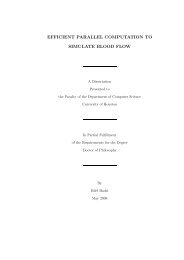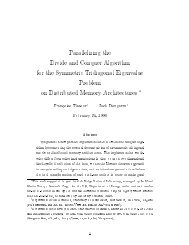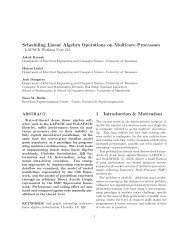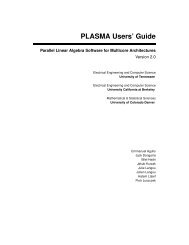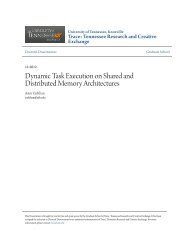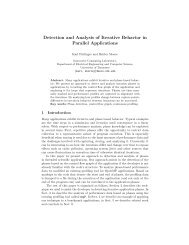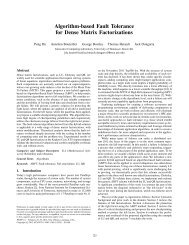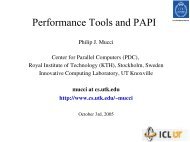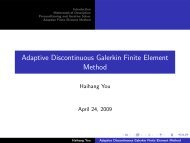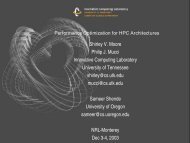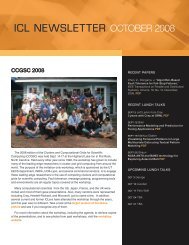Fast and Small Short Vector SIMD Matrix Multiplication ... - The Netlib
Fast and Small Short Vector SIMD Matrix Multiplication ... - The Netlib
Fast and Small Short Vector SIMD Matrix Multiplication ... - The Netlib
Create successful ePaper yourself
Turn your PDF publications into a flip-book with our unique Google optimized e-Paper software.
out. Typically, the two conversions are combined in<br />
one operation, which introduces an acceptable overhead<br />
[23].<br />
An easy way to picture the C = C − A × B T operation<br />
is to represent it as the st<strong>and</strong>ard matrix vector<br />
product C = C − A × B, where A is stored using<br />
row-major order <strong>and</strong> B is stored using column-major<br />
order. It can be observed that in this case a row of<br />
A can readily be multiplied with a column of B to<br />
yield a vector containing four partial results, which<br />
need to be summed up to produce one element of<br />
C. <strong>The</strong> vector reduction step introduces superfluous<br />
multiply-add operations. In order to minimize their<br />
number, four row-column products are computed, resulting<br />
in four vectors, which need to be internally<br />
reduced. <strong>The</strong> reduction is performed by first transposing<br />
the 4 × 4 element matrix represented by the<br />
four vectors <strong>and</strong> then applying four vector multiplyadd<br />
operations to produce a result vector containing<br />
four elements of C. <strong>The</strong> basic scheme is depicted in<br />
Figure 2.<br />
A<br />
B<br />
C<br />
transpose<br />
reduce<br />
Figure 2: Basic operation of the C = C − A × B T<br />
matrix multiplication micro-kernel.<br />
<strong>The</strong> crucial design choice to be made is the right<br />
amount of unrolling, which is equivalent to deciding<br />
the right tile size in terms of the triplet {m, n, k} (Here<br />
sizes express numbers of individual floating-point<br />
values, not vectors). Unrolling is mainly used to minimize<br />
the overhead of jumping <strong>and</strong> advancing the index<br />
variable <strong>and</strong> associated pointer arithmetic. It has<br />
been pointed out in §5.1 that both jump <strong>and</strong> jump<br />
hint instructions belong to the odd pipeline <strong>and</strong>, for<br />
compute intensive loops, can be completely hidden<br />
behind even pipeline instructions <strong>and</strong> thus introduce<br />
no overhead. In terms of the overhead of advancing<br />
the index variable <strong>and</strong> related pointer arithmetic,<br />
it will be shown in §5.5 that all of these operations<br />
can be placed in the odd pipeline as well. In this situation,<br />
the only concern is balancing even pipeline,<br />
arithmetic instructions with odd pipeline, data manipulation<br />
instructions.<br />
Simple analysis can be done by looking at the<br />
number of floating-point operations versus the number<br />
of loads, stores <strong>and</strong> shuffles, under the assumption<br />
that the size of the register file is not a constraint.<br />
<strong>The</strong> search space for the {m, n, k} triplet is<br />
further truncated by the following criteria: only powers<br />
of two are considered in order to simplify the loop<br />
construction; the maximum possible number of 64<br />
is chosen for k in order to minimize the number of<br />
extraneous floating-point instructions performing the<br />
reduction of partial results; only multiplies of four are<br />
selected for n to allow for efficient reduction of partial<br />
results with eight shuffles per one output vector of C.<br />
Under these constraints, the entire search space can<br />
be easily analyzed.<br />
Table 2 shows how the number of each type of<br />
operation is calculated. Table 3 shows the number<br />
of even pipeline, floating-point instructions including<br />
the reductions of partial results. Table 4 shows<br />
the number of even pipeline instructions minus the<br />
number of odd pipeline instructions including loads,<br />
stores <strong>and</strong> shuffles (not including jumps <strong>and</strong> pointer<br />
arithmetic). In other words, Table 4 shows the number<br />
of spare odd pipeline slots before jumps <strong>and</strong><br />
pointer arithmetic are implemented. Finally, Table 5<br />
shows the size of code involved in calculations for<br />
a single tile. It is important to note here that the<br />
double-buffered loop is twice the size.<br />
It can be seen that the smallest unrolling with a<br />
positive number of spare odd pipeline slots is represented<br />
by the triplet {2, 4, 64} <strong>and</strong> produces a loop<br />
with 136 floating-point operations. However, this unrolling<br />
results in only 20 spare slots, which would<br />
6



